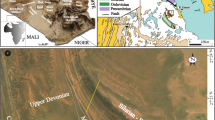Abstract
Palynological investigations are carried out on approximately 538.00-m thick Gondwana strata from borehole SKB-1, Binja Block, South Karanpura Coalfield in Jharkhand. Based on the distribution pattern of age marker palynotaxa, two distinct palynoassemblages are identified. Palynoassemblage-I in the lithologically designated Barren Measures and Barakar formations, between 552.00 and 53.20 m depth show dominance of striate bisaccate (Striatopodocarpites, Crescentipollenites, and Faunipollenites) and abundance of nonstriate bisaccate (Scheuringipollenites). Upward the Palynoassemblage-II (39.50–13.80 m depth) is rich in striate bisaccate (Striatopodocarpites and Crescentipollenites) and significant enveloping monosaccate Densipollenites magnicorpus pollen. These strata have been equated with Raniganj Formation of Latest Permian age. The First Appearance Datum (FAD) of Arcuatipollenites pellucidus, Playfordiaspora cancellosa, Alisporites sp., Falcisporites sp. and Krempipollenites indicus observed at 13.80 and 39.50 m depth, mark the transition of Permian into the Lower Triassic. The FADs of Guttulapollenites spp. at 49.10 and 504.70 m, Goubinispora morondavensis at 415.90 m, Alisporites ovalis and Arcuatipollenites sp. at 526.70 m is observed and suggest that these sediments are equivalent to Raniganj Formation, Late Permian in age.





Similar content being viewed by others
References
Bandyopadhyay N N 1984 A reappraisal of microfloral assemblage from Barakar stage of South Karanpura Coalfield, Bihar with remarks on the age of the coal beds; In: Symp. Evolutionary Bot. & Biostratigraphy, Calcutta (1979) (eds) Sharma A K et al., pp. 303–314.
Bharadwaj D C and Prakash Anand 1972 On the palynostratigraphy of Argada S Seam, South Karanpura Coalfield, Bihar; Palaeobotanist 19(1) 211–213.
Bharadwaj D C and Dwivdi A 1981 Spore dispersae from the Barakar Sediments from South Karanpura Coalfield, Bihar, India; Palaeobotanist 27 21–94.
Bharadwaj D C and Tiwari R S 1968 Sporological correlation of coal seams in Saunda and Gidi area of South Karanpura Coalfield, Bihar; Palaeobotanist 16 (1) 38–55.
Bharadwaj D C and Tripathi A 1978 A palynostratigraphic study of Lower Gondwana sediments from South Karanpura Coalfield, Bihar, India; Palaeobotanist 25 39–61.
Bhattacharya D, Ray Chudhury T, and Dutta K 1957 On fossil spores and pollen from the Lower Gondwanas of the Raniganj and South Karan coalfields; Quart. JI. Geol. Minearal. Metall. Soc. India 29 (1) 51–52.
Khan A M 1962 Palynological study of drill cores from B.H.K. Su 47, South Karanpura Coalfield, Bihar; Indian Mineral. 16(3) 307.
Khan A M 1964 A note on trilete, monolete, monocolpate miospore from the Barakar coals, South Karanpura Coalfield; Indian Mineral. 18(1) 93.
Lele K M and Chandra M 1977 Association of Mio and Megafloras in the roof shales of some Barakar coal seams, South Karanpura Coalfield, Bihar; Palaeobotanist 24(3) 254–260.
Lele K M and Kulkarni S 1969 Two miospore assemblages from the Argada Sector, South Karanpura Coalfield, Bihar, with remarks on the probable age; Palaeobotanist 17 (3) 288–294.
Raja Rao C S 1987 Coalfields of India; Bull. Geol. Surv. India A-IV 45 (I) 60.
Tiwari R S and Tripathi A 1992 Marker assemblage zones of spore and pollen species through Gondwana Palaeozoic and Mesozoic sequence in India; Palaeobotanist 40 194–236.
Acknowledgements
Authors (Archana Tripathi and S Murthy) are thankful to Director, BSIP, Lucknow for kindpermission to publish this work. They extend their sincere thanks to the Deputy Director General and officers of the Coal Wing Division, Geological Survey of India, Kolkata, for providing borecore samples for the present palynological study. This work has been carried out under MOU between BSIP and Coal Wing Division, Geological Survey of India, Kolkata. Authors also extend sincere thanks to reviewer Dr Ana M Zavattiieri for critical suggestions and comments, which have greatly improved the earlier version of the manuscript.
Author information
Authors and Affiliations
Corresponding author
Rights and permissions
About this article
Cite this article
Murthy, S., Tripathi, A., Chakraborti, B. et al. Palynostratigraphy of Permian succession from Binja Block, South Karanpura Coalfield, Jharkhand, India. J Earth Syst Sci 123, 1895–1906 (2014). https://doi.org/10.1007/s12040-014-0505-1
Received:
Revised:
Accepted:
Published:
Issue Date:
DOI: https://doi.org/10.1007/s12040-014-0505-1




